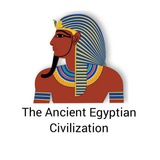From the details of displaying the artifacts at the Bulaq Museum before they were transferred to the Khedive Ismail Palace in Giza and then to the Egyptian Museum.
#TheEgyptianMuseum
#TheEgyptianMuseum
The details of the re-display of Glass Vessels within the work of the Greco-Roman Department of the Egyptian Museum ca. 332 BC – AD 364 Glass vessels were used for cosmetics, oils, perfumes, spices, pigments, and medicine in the ancient world, the essential ingredient of glass was silica, which came in the form of sand or flint, or quartz pebbles. It was combined with an alkaline material to lower the melting point, providing more time to shape the glass. Metallic oxides were added to produce blues and greens, while reds and oranges required more complex methods. The colorless glass was achieved by adding manganese. Glass was most commonly shaped using molds and tong-like tools to create designs and shapes. Trails, such as the black and white were pushed into the walls of a vessel by rotating it against a smooth slab, and impressions were made using a variety of tools.
#TheEgyptianMuseum
#TheEgyptianMuseum
A rare picture of the visitors of the Egyptian Museum and the display of the artifacts at the beginning of the twentieth century.
#TheEgyptianMuseum
#TheEgyptianMuseum
The Egyptian Museum has the honor to invite you to attend a lecture entitled "The royal and non-royal sources of the books of the afterlife in the Egyptian museum" by Dr.Khaled Abdel Ghany Associate professor in the Egyptology and coptic seminar at the gottingen University in Germany On Monday , March 12, 2023, at 1:30 in Hall 39 in the Egyptian Museum.
#TheEgyptianMuseum
#TheEgyptianMuseum
A Golden scorpion with a human head wearing Hathor Headdress
found in the tomb of Queen Karomama, wife of Takelothis II and mother of Osorkon III Dynasty 22 (945-712 BC) found in Tell el-Muqdâm (Leontopolis). Displayed in the Egyptian Museum in Tahrir, Cairo.
#TheEgyptianMuseum
found in the tomb of Queen Karomama, wife of Takelothis II and mother of Osorkon III Dynasty 22 (945-712 BC) found in Tell el-Muqdâm (Leontopolis). Displayed in the Egyptian Museum in Tahrir, Cairo.
#TheEgyptianMuseum
From the visit of actress Mary Munib and members of Naguib Al-Rihani to the Egyptian Museum from the Makram Salama archive.
#TheEgyptianMuseum
#TheEgyptianMuseum
The Egyptian Museum has the honor to invite you to attend a lecture entitled "Secrets of Tutankhamun's Necklace" presented by Prof. Dr. Magda Abdallah, Professor of History and Antiquities of Egypt and the Ancient Near East, Head of the History Department of the Faculty of Arts, Kafr El-Sheikh University, Deputy Director of the Regional Center for Antiquities, Arts and ancient Civilizations at the Arab Council of the general Union of Arab Archaeologists on Wednesday, March 15, 2023 at 12:30 in Hall 39 in the Egyptian Museum in Tahrir, Cairo.
#TheEgyptianMuseum
#TheEgyptianMuseum
Within the framework of the Egyptian Museum in Tahrir’s keenness to spread archaeological, cultural, and tourism awareness among all segments of society, and its belief in the museum’s role as a cultural and educational institution, the museum receives a number of Egyptian visitors, foreign tourists, many official delegations and public figures, as well as school and university trips from all over Egypt. The Egyptian Museum in Tahrir is one of the most important archaeological destinations in Egypt - one for Egyptian visitors and foreign tourists to enjoy and where they can learn about ancient Egyptian civilization. The Egyptian Museum has been considered one of the most important museums in the world since its opening in 1902.
#TheEgyptianMuseum
#TheEgyptianMuseum
The visit of the scientific trip of the Faculty of Archaeology, the third and fourth stages, Sohag University, and the visit was received by Prof. Dr. Ali Abdel Halim, Director General of the Egyptian Museum and the Chief Curator of the Museum Ms. Wafa Habib. The visit was accompanied by the curator of the Egyptian Museum, Mr. Medhat Nabil Within the framework of the Egyptian Museum in Tahrir’s keenness to spread archaeological, cultural, and tourism awareness among all segments of society, and its belief in the museum’s role as a cultural and educational institution
#TheEgyptianMuseum
#TheEgyptianMuseum
